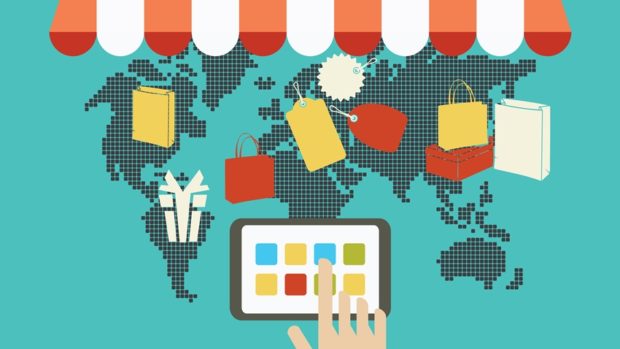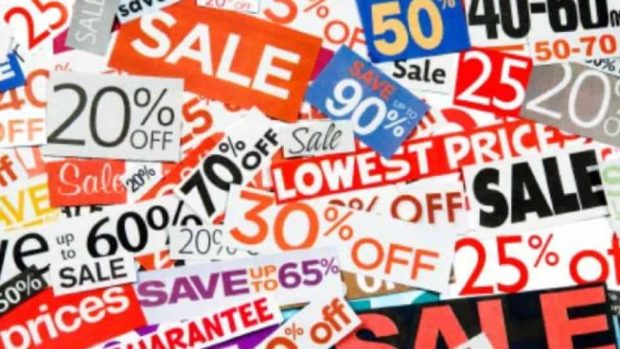
BASKET-TO- ORDER RATE
Basket-to-order rate is the orders divided by the people that add an item to the basket. Typically, we split this down into basket to checkout and checkout to order, but sometimes there is so much funky stuff such as PayPal Express going on at the basket it’s good to have an overall number. This is a great metric to improve and many sites want to jump to this straight away. However, we usually find we can get more revenue from improving the add-to-basket rate first and then optimising the higher numbers of shoppers later that this provides.
GETTING VISITORS TO PROCEED TO CHECKOUT
Remember, according to our statistics, an average of 55 per cent of the people who have added something to their basket will click Proceed to Check Out. While this may seem like a low percentage, there are several reasons that people abandon ship at this point in time.
COUPON CODES AND PAYPAL EXPRESS
With one of our clients, for instance, the issue was occurring in the coupon code section of the basket page. After discovering this, we had the system e-mail us immediately each time there was a failed coupon. Most of the coupon codes entered that were considered duds had only one digit wrong. Because they didn’t work, however, the customer abandoned his basket and left the website. This resulted in a lot of lost revenue for our client. To solve this, we made the decision, with the client, to apply the discount automatically. This way, even if the client accidentally got the coupon code wrong, he would still receive the discount and proceed to checkout. This one change alone makes the client over £1 million every year.
Another roadblock that may be discouraging customers from clicking proceed to checkout is actually PayPal Express. We found that this is beneficial when it comes to new customers, but not so much when it comes to recurring customers. After researching this phenomenon, we’ve determined that new customers enjoy using Paypal Express because it’s a safer way for them to pay for your products. They don’t quite trust you yet, so safety is key for them. Test it to see how it works for you.
To encourage customers to proceed to the next step, or purchase the items, make sure the basket clearly shows exactly what the product will cost them, and how long delivery is going to be and how much. Also make the payment icons really prominent on the basket page. Companies like Visa and Mastercard spend millions of dollars annually to associate their logos with trust. Leverage this marketing to increase the basket-to-order KPI. This takes away a lot of anxiety your customers may have about their purchase.
The browser abandonment pop-ups can be very useful here as well. If a customer starts to exit the page, a pop-up offering them an additional 10 per cent off might just sway them to stay. Just make sure the pop-ups are timed perfectly to catch a buyer’s attention.
GETTING VISITORS FROM CHECKOUT TO ORDER CONFIRMATION
Approximately 84 per cent of visitors go from checkout to order confirmation. Most individuals with eCommerce sites worry about this part of the process, mainly because it’s easy to see what the consequences (the lost revenue) are. As soon as you put your events into Google Analytics, you can see the amount of money, to the penny, you’re losing.
That can be scary because seeing these numbers, you may say, ‘Hey, wait a minute, we just lost twenty thousand pounds over the past month from one step of the checkout process to the next!’
The reality is, you’re going to lose some of your customers at this step, but this is also the area where you can get the best win if you’ve established your value proposition right, have a competitive product, are selling at the right price, have your site merchandised properly and have your delivery terms sorted out. People are more likely to put up with a checkout process that doesn’t work that well or is slightly confusing if they really want the product (because your value proposition is so good).
So, how can you easily improve the checkout process?
Here’s some things to look at, but they may be disappointing for those of you looking for a quick fix or a one-size-fits-all solution…
DIFFERENT CHECKOUTS WORK ON DIFFERENT PLATFORMS AND DIFFERENT BUYERS
Finding the right checkout for your website requires a bit of testing. Certain checkouts work differently for certain platforms and certain buyers. For instance, we decided to do a test with a checkout that let users play with the quantity throughout the entire checkout process, up to the final stage. At any point, they could decide they wanted three of the product instead of just one. When we began using the checkout page on different platforms, we noticed that, on the iPad, the conversion rate dramatically increased. On the desktop, however, it made no difference in revenue at all.
Maybe it’s psychological and iPad shoppers are in shopping mode instead of work mode, so they are more likely to increase their purchase amount. We haven’t quite figured out why, but the point here is to go ahead and make small changes as long as you are tracking the results.
We have also tested different types of platforms and found that some are more likely to be used by those making rational purchases, while others are better for emotional buys.
The one-page checkout on the left in the above chart worked better on sites where rational purchases were made. It also appealed to younger buyers. The one on the right is a more methodical, step-by-step approach that the older generation and those making emotional, spontaneous purchases enjoy.
The extensions for eCommerce checkout pages are simple to work with, and most often, if you’ve taken the time to invest in the add-to-basket rate and basket to checkout, you won’t have to worry much about the final checkout-to- order confirmation step. The secret to scaling your business is to figure out where you’re losing customers.
Here’s a checkout to go through to help raise the basket-to-order rate, i.e. what if it’s below 30 per cent? If you have 4000 people add something to the basket and less than 1200 proceed to checkout, then that’s bad.
Let’s look at the things that many people get wrong.
- Proceed to checkout below the fold. Even if people have a lot in their basket, don’t let the Proceed to Checkout button get pushed down below the fold. Ideally have it both at the top and the bottom.
- Payment icons such as Visa, Mastercard, etc. These companies spend millions if not billions a year associating these logos with trust in the minds of the consumer. So, make sure you leverage this by showing them above the fold.
- Payment icons on every line item in the basket. I have seen split tests convert higher when payment icons are shown next to each item in the basket rather than just at the bottom.
- Use wording like ‘continue securely’ rather than ‘proceed to checkout.’ This split tested higher for us as people are worried about security online.
- Make sure that the basket is nicely laid out and does not look complicated. Remember perceived ease of use is pretty much equal to actual ease of use. Don’t over complicate and get a usability designer to design your basket.
- Don’t make your product images too small. People need to maintain the desire for the product they are buying and making them too small means they might lose their interest. The desire for the product must be bigger than the pain of paying for them.
- Have a clear colour for the Proceed to Checkout button. Make this a colour that is not used anywhere else in the design, so it stands out. Also, it should be the same colour as all the Move Forward buttons on the store, i.e. the add-to-basket, proceed-to-checkout and Confirm Order buttons should all be the same colour.
- Delivery should be clearly displayed—how long it will take and how much it will be. Preferably delivery will be free or free over a certain amount. If they have qualified for free delivery, shout about it and make it dynamic when the threshold is reached.
- If you have a free delivery threshold and the person has not hit that level yet, tell them exactly how much more they need to spend to hit free delivery, i.e. spend £5.50 more to qualify for free delivery.
- Make your return policy clear. People will be asking, what if I don’t like it? Don’t hide your return policy in the footer of the site. The return policy should be a good policy and it should be a selling point.
- If people use a lot of coupons on your store, make sure you monitor coupons that fail to trigger a discount. Get these to be emailed to you so you can spot common misspelling or typos of active coupons. Often you can create coupons of these typos so that you get the orders.
- Make live chat prominent on the basket page so that buyer questions can be answered quickly.
- Use countdown timers to show how long it is till they qualify for next- day delivery.
- Use countdown timers to show how long it is till the coupon they have used expires.
- Use third-party review stars and reviews to give people confidence that you can deliver the product on time.
HOW FAST ARE BUYERS ON YOUR CHECKOUT?
How do we know if the checkout is a problem?
Mark’s son did swimming sports recently. He was doing well until, whilst doing backstroke, he cruised at the end because he was afraid of hitting his head on the wall. He only races once a year and he really isn’t bothered about where he places.
But it made Mark think about how we had no idea if he was a fast swimmer or not. He swims a lot and seems fast, but it is only when he swims next to others do we find out if he is fast. Also, it clearly identifies an issue with his technique. Swimming at the end with one arm above your head for a quarter length of the pool, just in case you hit your head, is going to slow you down a bit. Now we know what’s wrong we can fix it.
This is like your checkout page. It looks fine. Chugging all day and sending you order confirmation emails. But how fast is it? Let’s have a look at five retailers and see how long people on average spend on the checkout page. After this we can compare the results.
Some of our clients use the one-step checkout, which is all the checkout on one page and thus makes it easy to find the ‘time on page’ for each one. Here’s how they looked last month:
- B2B Site A selling spare parts: Average time on checkout page—3 minutes 7 seconds.
- B2B Site B selling lab equipment: Average time on checkout page—3 minutes 40 seconds.
- B2C Site C selling clothing: Average time on checkout page—2 minutes 50 seconds.
- B2B Site D selling protective equipment: Average time on checkout page—2 minutes 33 seconds.
- B2C Site E selling food: Average time on checkout page—2 minutes 32 seconds.
- B2C Site F selling flowers: Average time on checkout page—3 minutes 59 seconds.
So how does the checkout race look? Well, we might argue that Business 2 Business (B2B) site checkouts are a little slower than Business to Consumer (B2C) sites. This would make sense as people might have to look up addresses, etc., when buying for work.
But site F selling flowers does look slow, doesn’t it? Almost 4 minutes against an average time on B2B sites of 2–3 minutes.
Next step would be to record some browser sessions of site E and then some browser sessions of site F. We could then compare the behaviour and find out what people are struggling with.
Where there is struggle, there is always checkout abandonment, so this will be very lucrative work indeed.
THINK ABOUT THE FLOW OF BUYER
Next we want to introduce the concept of ‘visitor flow’ through the website. Don’t treat each page on your site as an island, just as important is how people move through those pages.
A good metaphor for an eCommerce customer journey is packing to go on holiday.
When Mark travels he likes to pack well in advance and check he has everything he might need. Contact lens solution, swimming trunks, glasses— all the things he has forgotten in the past. He packs and then checks his suitcase a lot to make sure it’s still correct.
He always checks that he has his passport multiple times before he leaves the house, even though he knows it’s there. He has multiple items to pack and he wants to be confident that he has them. His nervousness around packing is exactly how buyers feel about their basket on an eCommerce site.
Most eCommerce stores seem to think that there is a one-size-fits-all strategy to how the flow should work on their websites.
By flow we mean what happens when someone adds something to their basket, where they get taken and what happens. They go and see how Amazon does it or ASOS and then copy that.
Many sites keep people on the product page and then have a ‘hover reveal’ for the basket icon to show what’s in the basket. If people want to actually visit the basket page, then they have to click in the basket reveal to see basket.
Often some of these sites funnel people directly to the checkout. Nobody seems to question this.
But the flow people take when moving through the site has a massive impact on the conversion rate. There is no one size fits all. Why is this? Because on some sites people tend to only add one item to the basket and check out (a dress website). Other sites, like a herb and spices site, people will tend to add five to seven items to the basket before checking out.
On sites that people add more items to the basket on average, the basket is an important page.
Coming back to our packing analogy. If we were packing a suitcase and could not look in the suitcase once we’d put something in it, then we would get nervous when leaving the house. How could we check we had everything we needed?
This nervousness increases with the number of items people add to the basket. We need to reduce this nervousness to a minimum if we want people to check out. On many sites with many items in the basket, the basket hover in the top right just doesn’t cut it.
The customer is not aware of why they are nervous, they can see what’s in the basket on the hover. But because the hover is small and hard to see it does not give them the confidence that seeing the products nicely laid out on the basket page does.
When we worked on the conversion rate for one of the world’s largest wine sites we told them that people needed to be taken to the basket page when they added something to the basket. This simple change gave them an extra 3 million GBP in revenue per year. This was because the wine site made people order a crate of wine and choose at least six bottles. They needed to be on the basket page to see the collection they had chosen and fall in love with it. They couldn’t engage with the wines they had chosen on a small hover window.
If you have a high average amount of different products in customers’ baskets, don’t skip the basket page. It’s important.
You need to map out the flow of your site to fit how your shoppers shop. Don’t blindly copy other websites; even your competitors have probably got it wrong.
The flow of the purchase is key.
HOW TO RAISE THIS KPIóBASKET TO ORDER RATE
Here are some quick wins for you from our time in the trenches.
- Make sure you use a tool like Mouseflow to capture users’ sessions on the checkout pages. We built a team in the Philippines just to do this as we found lots and lots of errors and quick fixes on basically any site we looked at. Mouseflow has a good tag called ‘click rage’ which shows when people get really frustrated and this can lead to areas where there are problems.
- Look for JavaScript errors in Mouseflow recordings as it can highlight a particular platform, e.g. Amazon Silk, that does not work with your website. Often these are easy fixes.
- The basket page also needs to sell; don’t have a tick-in-the-box basket page, it needs to drive momentum throughout the sale. Make sure the basket page answers all the objections people have at this stage such as:
» How much is delivery?
» What about returns?
» Is this item difficult to deliver?
» How much discount am I getting?
» How quick is delivery?
» What guarantees is there about this product?
» Why should we do this today rather than tomorrow?
- Also, don’t think that one checkout flow is going to work across all devices. What works on desktop might totally annoy on the mobile site. Split test each platform separately and find what works for each. Mobile is much more about ease of use; desktop is more about convincability.
- Is your lost password functionality annoying? If they have just typed in their email and got the wrong password, then for god’s sake, remember the email just typed in on the lost password form. Such a silly, easy thing to do but hardly anyone does it.
- For people who cannot remember their password let them check out as guests if they want and just add their order to the same email address if it exists in the database. Make it easy, not hard.
- Make reward points easy to understand, easy to add, paint-by-numbers approach rather than War and Peace.
- Keep a picture of the products all the way through the checkout, especially if you are selling aspirational items. Taking the product imagery away will separate the user from the want of the item, making it easier for them to abandon.
- Add social proof all the way through the checkout: David just bought, etc.
- Use secure wording on the checkout to show that the checkout is secure and not likely to get hacked.
- Bring payment logos like Visa, Mastercard above the fold and add them to each line item on the basket. These billion-dollar firms spend untold millions each year associating these brand logos with trust. Leverage their marketing spend to increase checkout conversion rates.
- Split test Checkout and Basket Proceed button colours; it can have more impact than you would expect.
- Split test removing the main navigation for the checkout pages. Do people get distracted and leave the site for Facebook, etc.?
- Split test using one-click ordering services like Amazon Pay, Paypal Express, etc., to see if this increases conversion.
- For B2B sites offer an invoice option.
- Offer an AfterPay-type payment service where the user can split the payment into 10 payments, interest-free.
- Add live chat to the checkout page that listens for page activity that could signal issues, such as javascript errors, click rage, the filling out of fields over and over, or the repeated clicking of buttons. Then auto prompt, ‘Are you having an issue we can help with?.’ Make this help 24/7 by using UK and overseas teams for this important page. At the very least the chat support team can raise a ticket and make sure it does not happen again.
RECAP: BASKET-TO-ORDER RATE
The issues that prevent customers from getting from the basket to checkout are typically small, yet significant. Trouble with coupons or the use of PayPal Express are two of the most common problems we see.
KPI: BASKET-TO-ORDER RATE
The number of orders divided by the people that add an item to the basket.
Put it to use:
- Only 55 per cent of people who add something to their basket will proceed to checkout.
- Simple things can result in lost customers, such as coupon codes with one digit wrong.
- PayPal Express works well with new customers, but not with recurring customers. New customers don’t trust you yet.
- Display every detail, including cost of product, delivery options and payment icons on the basket page. There should be no surprises.
- 84 per cent of customers go from the checkout to order confirmation.
- Split test different types of checkouts on different platforms to see what works best.
Answer the following:
- Do you offer coupon codes? If so, what happens, right now, if a customer enters the coupon code wrong? How would you handle it better? Think of it the same way a physical sales assistant would.
- Split test your checkout payment options. See which one works better: Paypal Express or credit card payments. Which one is more successful on your website?
- What does your checkout basket look like? Are all the details a customer needs in one place? Write down where the basket is excelling and where it is lacking.
- Does your checkout work on all platforms? Check this carefully. If your checkout isn’t working on an iPad, but works on the desktop, you could be losing customers.








Share